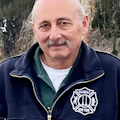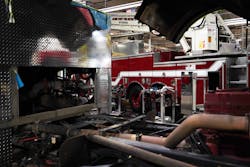It’s time to replace a vehicle that’s in the fleet. Do you buy new? Can you afford to buy new? If the answer is no, then you need to look at what your refurbishing options are.
NFPA 1912: Standard for Fire Apparatus Refurbishing is the document that you must consult for a refurbishment project. The NFPA uses two classifications for refurbishment that are based on the amount and type of work to be done. They are:
- 3.3.42.1 Level I Refurbishing. The assembly of a new fire apparatus by the use of a new chassis frame, driving and crew compartment, front axle, steering and suspension components, and the use of either new components or components from an existing apparatus for the remainder of the apparatus.
- 3.3.42.2 Level II Refurbishing. The upgrade of major components or systems of a fire apparatus with components or systems that comply with the applicable standards in effect at the time the original apparatus was manufactured.
Both of the options have further guidance in Annex A that should be read. Note that neither one of these options mentions the engine, transmission and drive axle. In a Level I refurbishment, these aren’t mentioned purposely, so that the “glider kit” option remains as a choice. Level II doesn’t reach that level of work.
Scrutiny
“Remount” usually isn’t used with fire apparatus, but it’s common in the EMS world. Many ambulance companies operate on the premise that the body of the ambulance will be “remounted” twice. This means that an ambulance body will be in service on three cab and chassis assemblies before the end of its projected lifespan. Is this feasible for fire apparatus? Three cab and chassis assemblies? Probably not. Two? Maybe.
Like so many other decisions that you must make about fleet management, this isn’t a cut and dried scenario. A remount uses parts and components from your existing apparatus, but it involves an entirely new cab and chassis assembly.
For the purposes of illustration, I will use a triple combination pumper as an example.
Deciding which of the refurbishing options that you choose begins with inspection and understanding of the apparatus that’s under consideration for refurbishment.
Your intention might be to do a Level II refurbishment, but conditions that are found when the apparatus is surveyed might indicate that refurbishment is impractical and ill-advised.
Where do you begin? Start by reading The Apparatus Architect article, “Fleet Alternatives to Buying New”. Excellent information and considerations are highlighted.
The next step in the process is to look at the apparatus that’s being considered for refurbishment with a critical eye.
Does the vehicle still service the operational needs of your department? In conjunction with this, do the pump and its components meet your needs? Are upgrades to the pump and its components needed to meet current operational needs? What are your “wish list” upgrades, if any?
Does the compartment body meet the currents need for tool and equipment storage? If not, what changes are needed?
Send a sample of the motor oil, transmission fluid (automatic or manual), pump transmission fluid and rear end fluid to a laboratory for analysis. The comprehensive information that you get back will show whether there is a developing problem with these major components that could add significant cost to the refurbishment. This can include something that must be rebuilt or replaced that you didn’t consider.
Perform a detailed physical inspection of the apparatus and its components. Are the apparatus chassis rails rust-jacked or deteriorated to the point that they must be replaced? Are there structural issues with the compartment body, pump house and/or cab?
Review the annual test reports for the past five years and the vehicle maintenance records for the past three years for the vehicle. Look for recurring problems and decreased performance.
Costs
Budget drives every decision that we make with fleet services. All of the considerations and questions that are referenced above have a cost that’s associated with them. Although almost everything is repairable, and almost any changes can be made, the question is, does the repair or change make sense operationally and economically?
A realistic budget must be set for the project. This helps to ensure that the refurbishment project is a success and that the finished product meets your apparatus needs. That said, cost is a difficult thing to quantify. If you’re looking for general guidelines, SVI Trucks, through its SVI Refurb group, provides helpful information.
In general terms, a remount that falls under the NFPA Level I Refurbishing guidelines will be the most expensive option, followed by a more traditional Level I or glider kit project. The least costly option most likely will be a Level II refurbishment.
Having been involved in several refurbishment projects, I can offer this insight:
- From a budgeting standpoint, always budget a minimum of 25 percent more than what the refurbishment center that you will use told you that the project will cost. There always will be additional work that’s needed that wasn’t detected until the apparatus is disassembled.
- If you refurbish an aerial device, go back to the original manufacturer. Let the people who engineered that aerial device supervise the refurbishment work.
- If the manufacturer of the apparatus that’s being considered for refurbishment is out of business, don’t waste your money.
- If the apparatus was a marginal vehicle before it was refurbished, it will be a marginal vehicle after it’s refurbished. If the apparatus was a good vehicle prior to it being refurbished, it will be a good vehicle after it’s refurbished.
Good planning is the key to it all.
About the Author

Jeffrey D. Gaskin
Jeffrey D. Gaskin is president of Big Red Trucks Fire Apparatus Consultants. He is a retired captain from the Scarsdale, NY, Fire Department. Throughout his career, Gaskin has been involved in apparatus acquisitions, from needs assessment through specification-writing. He also is a fire apparatus mechanic and holds certifications from Allison Transmission, Detroit Diesel, Hale Pump, Smart Power, Spartan Chassis, Sutphen Fire Apparatus and others. Gaskin is certified by the Emergency Vehicle Technician Certification Commission in six areas: Fire Apparatus Inspection, Maintenance and Testing (F-1); Design and Performance Standards of Fire Apparatus (F-2); Fire Pumps and Accessories (F-3); Aerial Fire Apparatus (F-5); Allison Automatic Transmission (F-6); and Hydraulic Systems (F-8). He can be reached at [email protected].
